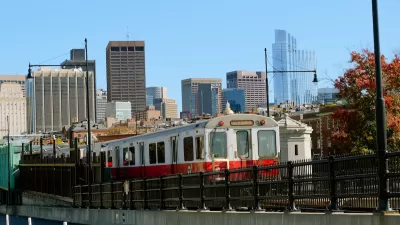Ruth Graham details the work of Franz-Josef Ulm, who is developing a theory of "urban physics" that compares the structure of cities to materials found in nature. Boston, for instance, is disorderly like water (and Los Angeles).
According to Graham, Ulm's work analyzes cities "the way you’d analyze a material, looking at factors such as the arrangement of buildings, each building’s center of mass, and how they’re ordered around each other." Some of Ulm's conclusions: "Boston’s structure, for example, looks a lot like an 'amorphous liquid.' Seattle is another liquid, and so is Los Angeles. Chicago, which was designed on a grid, looks like glass, he says; New York resembles a highly ordered crystal."
"If the analogy does hold up, Ulm hopes it will give planners a new tool to understand a city’s structure, its energy use, and possibly even its resilience to climate change."
Graham's article includes Ulm's work among the inroads made by researchers in the "science of cities" by quoting Michael Mehaffy, who wrote on that subject for Planetizen in June. Mehaffy's take on Ulm's work: although it's "fascinating and potentially very important," but that comparisons can be reductive of the unique structures of cities.
FULL STORY: What ‘urban physics’ could tell us about how cities work

Planetizen Federal Action Tracker
A weekly monitor of how Trump’s orders and actions are impacting planners and planning in America.

Congressman Proposes Bill to Rename DC Metro “Trump Train”
The Make Autorail Great Again Act would withhold federal funding to the system until the Washington Metropolitan Area Transit Authority (WMATA), rebrands as the Washington Metropolitan Authority for Greater Access (WMAGA).

The Simple Legislative Tool Transforming Vacant Downtowns
In California, Michigan and Georgia, an easy win is bringing dollars — and delight — back to city centers.

The States Losing Rural Delivery Rooms at an Alarming Pace
In some states, as few as 9% of rural hospitals still deliver babies. As a result, rising pre-term births, no adequate pre-term care and "harrowing" close calls are a growing reality.

The Small South Asian Republic Going all in on EVs
Thanks to one simple policy change less than five years ago, 65% of new cars in this Himalayan country are now electric.

DC Backpedals on Bike Lane Protection, Swaps Barriers for Paint
Citing aesthetic concerns, the city is removing the concrete barriers and flexposts that once separated Arizona Avenue cyclists from motor vehicles.
Urban Design for Planners 1: Software Tools
This six-course series explores essential urban design concepts using open source software and equips planners with the tools they need to participate fully in the urban design process.
Planning for Universal Design
Learn the tools for implementing Universal Design in planning regulations.
Smith Gee Studio
City of Charlotte
City of Camden Redevelopment Agency
City of Astoria
Transportation Research & Education Center (TREC) at Portland State University
US High Speed Rail Association
City of Camden Redevelopment Agency
Municipality of Princeton (NJ)





























